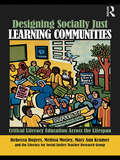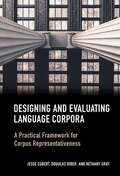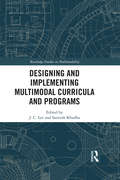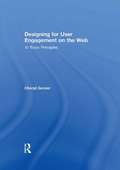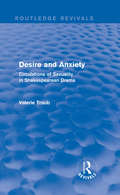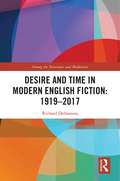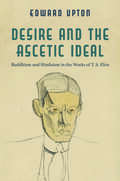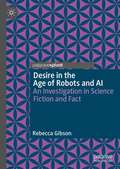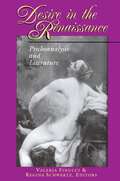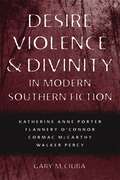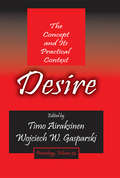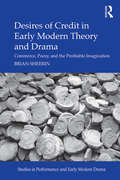- Table View
- List View
Designing Socially Just Learning Communities: Critical Literacy Education across the Lifespan
by Rebecca Rogers Mary Ann Kramer Melissa Mosley The Literacy for Social Justice Teacher Research GroupDemonstrating the power and potential of educators working together to use literacy practices that make changes in people's lives, this collaboratively written book blends the voices of participants in a teacher-led professional development group to provide a truly lifespan perspective on designing critical literacy practices. It joins these educators’ stories with the history and practices of the group - K-12 classroom teachers, adult educators, university professors, and community activists who have worked together since 2001 to better understand the relationship between literacy and social justice. Exploring issues such as gender equity, linguistic diversity, civil rights and freedom and war, the book showcases teachers’ reflective practice in action and offers insight into the possibilities and struggles of teaching literacy through a framework of social justice. Designing Socially Just Learning Communities models an innovative form of professional development for educators and researchers who are seeking ways to transform educational practices. The teachers' practices and actions – in their classrooms and as members of the teacher research group – will speak loudly to policy-makers, researchers, and activists who wish to work alongside them.
Designing Technical and Professional Communication: Strategies for the Global Community
by Deborah C. Andrews Jason C. ThamThis concise and flexible core textbook integrates a design thinking approach, rhetorical strategies, and a global perspective to help students succeed as technical and professional communicators in today’s multimodal, mobile, and global community. Design thinking and good communication practices are rooted in empathy and human values. The integrated approach fosters students' ability to address the complex problems they will face in their careers, where they will collaborate with people who present diverse expertise, cultures, languages, and values. This book introduces the knowledge and skills as well as agile activities that help students communicate on projects within local and global communities. Parts 1 and 2 introduce the strategies for design thinking, audience analysis, communicating ethically, collaborating professionally, and managing projects to define problems and implement solutions. In Parts 3 and 4, students learn to compose content in text and visuals. They learn to structure and deliver content by choosing the right genre and selecting effectively from the communication options available in today's multimodal environment. Designing Technical and Professional Communication serves as a flexible core textbook for technical and professional communication courses. An instructor’s manual containing exercises, sample syllabus, and guidance for teaching in a variety of settings is available online at www.routledge.com/9780367549602.
Designing and Evaluating Language Corpora: A Practical Framework for Corpus Representativeness
by Douglas Biber Bethany Gray Jesse EgbertCorpora are ubiquitous in linguistic research, yet to date, there has been no consensus on how to conceptualize corpus representativeness and collect corpus samples. This pioneering book bridges this gap by introducing a conceptual and methodological framework for corpus design and representativeness. Written by experts in the field, it shows how corpora can be designed and built in a way that is both optimally suited to specific research agendas, and adequately representative of the types of language use in question. It considers questions such as 'what types of texts should be included in the corpus?', and 'how many texts are required?' – highlighting that the degree of representativeness rests on the dual pillars of domain considerations and distribution considerations. The authors introduce, explain, and illustrate all aspects of this corpus representativeness framework in a step-by-step fashion, using examples and activities to help readers develop practical skills in corpus design and evaluation.
Designing and Implementing Multimodal Curricula and Programs (Routledge Studies in Multimodality)
by Santosh Khadka J. C. LeeThis volume presents a comprehensive overview of multimodal approaches to curriculum and programmatic implementation across a diverse range of teaching environments and across geographic and cultural boundaries. Featuring contributions from scholars within and across both disciplines, the book examines the ways in which new technologies link to expanding definitions of literacy and, building on this, how multimodal approaches might most effectively address the unique opportunities and challenges instructors face in contemporary classrooms and professional development programs. Chapters draw on case studies from both existing scholarship and findings from the authors’ own experiences in practice, including examples from writing, rhetoric, and composition courses, open online learning courses, and interdisciplinary faculty training programs. The final section of the book showcases how the conversation might be further extended to address increasingly multilingual classrooms by exploring how multimodality has been implemented in transnational settings. Engaging with key questions at the intersection of programmatic and curricular development and multimodal studies, this book is a fundamental resource for graduate students and scholars in multimodality, rhetoric studies, language education, applied linguistics, and communication studies.
Designing for Newspapers and Magazines (Media Skills)
by Chris FrostA hugely beneficial introduction to students and professionals in print media and design, Designing for Newspapers and Magazines offers guidance on how to produce attractive publications and how to tailor them to their target audience using colour, text placement, typography and images.Written by an experienced journalist and designer, the book details the elements of good design and provides instruction on how to get the most of computers and computer-aided design.The book examines a broad range of local and national publications including The Sun, The Daily Mirror and Glamour magazine and explains the reasoning that underpins their design choice, including: how to set up a new publication planning an edition of a newspaper or magazine typography and working with text working with images and technical production designing pages and how to use colour design and journalism ethics a glossary of journalistic and design terms
Designing for Social Justice: Community-Engaged Approaches in Technical and Professional Communication (ATTW Series in Technical and Professional Communication)
by Jialei Jiang Tham, Jason C. K.Exploring the intersection of design research and community engagement, this book highlights the ways in which design and design theories can be used to address social justice issues and promote positive change in communities.Contributors illuminate the theoretical, ethical, and pedagogical dimensions of design-driven methods in community-engaged projects, exploring their potential to address critical social justice issues such as ethnic and racial justice, gender equality, disability justice, cultural diversity, equity, and environmental justice. Chapters examine various aspects of community-engaged practices, including the use of design theories to fuel social justice work in community partnerships, ethical issues surrounding the use of multimodal resources and new media technologies, and pedagogies for promoting social change. Addressing the opportunities and challenges of design and design methods in community engagement, this collection offers suggestions for promoting social justice through technical and professional communication activities and pedagogies.Investigating the design of community-engaged projects from a critical standpoint, this book will appeal to scholars and students in the fields of Technical and Professional Communication, Writing and Composition Studies, and Rhetoric. It will also be of interest to administrators, community partners, and professionals working in service-learning contexts.
Designing for User Engagement on the Web: 10 Basic Principles
by Cheryl GeislerDesigning for User Engagement on the Web: 10 Basic Principles is concerned with making user experience engaging. The cascade of social web applications we are now familiar with — blogs, consumer reviews, wikis, and social networking — are all engaging experiences. But engagement is an increasingly common goal in business and productivity environments as well. This book provides a foundation for all those seeking to design engaging user experiences rich in communication and interaction. Combining a handbook on basic principles with case studies, it provides readers with a rich understanding of engagement: extending a welcome, setting the context, making a connection, sharing control, supporting interaction, creating a sense of place, and planning to continue the engagement. Based on research funded by the Society for Technical Communication, the case studies illustrate how designers build community in order to support education, connect kids to community resources, introduce users to other cultures, foster collaboration, encourage activism, and much more. Whatever your motive, if you aim to create engaging user experiences, you will want to explore Designing for User Engagement on the Web.
Designing, Conducting, and Publishing Quality Research in Mathematics Education (Research in Mathematics Education)
by Keith R. LeathamThe purpose of this book is to collect, organize and disseminate collective wisdom with respect to designing, conducting, and publishing quality research in mathematics education. This wisdom will be gleaned from among those who, over the past several decades, have been instrumental in guiding the field in the pursuit of excellence in mathematics education research—insightful editors, educative reviewers, prolific writers, and caring mentors. Each chapter is written to the novice researcher with the intent of aiding them in avoiding common pitfalls, navigating difficult intellectual terrain, and understanding that they are not alone in experiencing rejection, frustration, confusion, and doubt. This book differs from existing literature in the sense that it is written about the enterprise of designing, conducting and publishing research in mathematics education as opposed to being reports of the results of such work. It also differs in the sense that it is written with the intent to mentor the rising generation as opposed to capture the state of the field (as would happen in a handbook, for example). It is written for the express purpose of helping the field work collectively to aid in the often isolated enterprise of mentoring new researchers. The primary audience is a potentially wide one: graduate students, novice researchers, graduate faculty, advisors, and mentors – or anyone seeking to improve their own abilities to design, conduct, and publish quality research in mathematics education.
Designs for Language Program Evaluation
by Paul GrubaThis book aims to advance language program evaluation and practice, building on the author's previous work in Blended Language Program Evaluation (Palgrave Macmillan, 2016). The book is based in theory, yet incorporates case study examples throughout each chapter. The conceptual framework is grounded in complexity and evaluative thinking, and incorporates a three-tiered approach on themes ranging from 'hybrid learning' through to 'leadership' and 'sustainability'. The style of the work seeks to engage stakeholders through its focus on utility and program improvement, and result in pragmatic, evidence-based results that foster quality teaching, learning, and administration. Despite being situated in a multibillion dollar global industry, few language professionals evaluate their language programs and foster improvement. This book is addressed to current language professionals and researchers, and aims to fill this gap in current knowledge and practice.
Desirable Literacies: Approaches to Language and Literacy in the Early Years (Published in association with the UKLA)
by Elaine Hallet Jackie MarshWhat are the ways in which young children learn to communicate? Collating their extensive experience of language and literacy in the early years, the contributors explore key aspects of this topic, linking practical ideas for early years settings and classrooms to relevant theory and research. This second edition is updated to take into account important developments in research, policy and practice, and now covers the 0-8 age range. It also addresses developments in new media and the impact this has upon literacy in young children, and offers chapters on new areas which have emerged in recent years, such as multimodality, media literacy, creative arts and literacy. Explored in the book are: - the relationship between play and literacy; - the role environmental print has in early literacy development; - the language and literacy development of young bilinguals; - ideas, suggestions and justifications for the use of poetry; - a two-year research project, funded by Creative Partnerships; and - key issues relating to family literacy.
Desire and Anxiety: Circulations of Sexuality in Shakespearean Drama (Routledge Revivals)
by Valerie TraubIn both feminist theory and Shakespearean criticism, questions of sexuality have consistently been conflated with questions of gender. First published in 1992, this book details the intersections and contradictions between sexuality and gender in the early modern period. Valerie Traub argues that desire and anxiety together constitute the erotic in Shakespearean drama – circulating throughout the dramatic texts, traversing ‘masculine’ and ‘feminine’ sites, eliciting and expressing heterosexual and homoerotic fantasies, embodiments, and fears. This is the first book to present a non-normalizing account of the unconscious and the institutional prerogatives that comprise the erotics of Shakespearean drama. Employing feminist, psychoanalytic, and new historical methods, and using each to interrogate the other, the book synthesises the psychic and the social, the individual and the institutional.
Desire and Domestic Fiction: A Political History of the Novel
by Nancy ArmstrongA foundational work of literary criticism dealing with the Victorian novel, sexuality, and the rise of the middle class.
Desire and Empathy in Twentieth-Century Dystopian Fiction (Palgrave Studies in Utopianism)
by Thomas HoranThis book assesses key works of twentieth-century dystopian fiction, including Katharine Burdekin’s Swastika Night, George Orwell’s Nineteen Eighty-Four, and Margaret Atwood’s The Handmaid’s Tale, to demonstrate that the major authors of this genre locate empathy and morality in eroticism. Taken together, these books delineate a subset of politically conscious speculative literature, which can be understood collectively as projected political fiction. While Thomas Horan addresses problematic aspects of this subgenre, particularly sexist and racist stereotypes, he also highlights how some of these texts locate social responsibility in queer and other non-heteronormative sexual relationships. In these novels, even when the illicit relationship itself is truncated, sexual desire fosters hope and community.
Desire and Infinity in W. S. Merwin's Poetry
by Dong FengIn the first monograph on W. S. Merwin to appear since his death in 2019, Feng Dong focuses on the dialectical movement of desire and infinity that ensouls the poet’s entire oeuvre. His analysis foregrounds what Merwin calls “the other side of despair,” the opposite of humans’ articulated personal and social agonies. Feng finds these presences in Merwin’s evocations of what lingers on the edge of constantly updated socio-symbolic frameworks: surreal encounters, spiritual ecstasies, and abyssal freedoms. By examining Merwin’s lifelong engagement with psychic fantasies, anonymous holiness, entities both natural and supernatural, and ghostly ancestors, Feng uncovers a precarious relation with the unarticulated, unrealized side of existence. Drawing on theories from Lacan, Žižek, Levinas, and Heidegger, Desire and Infinity in W. S. Merwin’s Poetry reads a metaphysical possibility into the poet’s work at the intersection between contemporary poetics, philosophy, and psychoanalysis.
Desire and Time in Modern English Fiction: 1919-2017 (Among the Victorians and Modernists)
by Richard DellamoraBeginning with Somerset Maugham’s innovative, sexually dissident South Seas novel and tales and Alfred Hitchcock’s gay-inflected revisiting of the Jack the Ripper sensation in silent film, this book considers the continuing presence of the past in future-oriented work of the 1930s and the Second World War by Sylvia Townsend Warner, Virginia Woolf, George Orwell, and the playwright and novelist, Patrick Hamilton. The final three chapters carry the discussion to the present in analyses of works by lesbian, postcolonial, and gay authors such as Sarah Waters, Amitav Ghosh, and Alan Hollinghurst. Focusing on questions about temporality and changes in gender and sexuality, especially gay and lesbian, straight and queer, following the rejection of the Victorian patriarchal marriage model, this study examines the continuing influence of late Victorian Aestheticist and Decadent culture in Modernist writing and its permutations in England.
Desire and the Ascetic Ideal: Buddhism and Hinduism in the Works of T. S. Eliot (Studies in Religion and Culture)
by Edward UptonThe Hindu words "Shantih shantih shantih" provide the closing of The Waste Land, perhaps the most famous poem of the twentieth century. This is just one example among many of T. S. Eliot’s immersion in Sanskrit and Indian philosophy and of how this fascination strongly influenced his work.Centering on Eliot’s study of sources from ancient India, this new book offers a rereading of the poet’s work, analyzing his unpublished graduate school notebooks on Indian philosophy and exploring Eliot’s connection with Buddhist thought. Eliot was crucially influenced by his early engagement with Indian texts, and when analyzed through this lens, his poems reveal a criticism of the attachments of human desire and the suggestion that asceticism might hold out the possibility that desire can be cultivated toward a metaphysical absolute. Full of such insights, Upton’s book represents an important intervention in modernist studies.
Desire and the Divine: Feminine Identity in White Southern Women's Writing (Southern Literary Studies)
by Kathaleen E. AmendeIn this groundbreaking study, Kathaleen E. Amende explores the works and lives of late-twentieth-century southern women writers to show how conservative Christian ideals of femininity shaped notions of religion, sexuality, and power in the South. Drawing from the work of authors such as Rosemary Daniell and Connie May Fowler, whose characters -- like the authors themselves -- grow up believing that Jesus should be a girl's first "boyfriend," Amende demonstrates many ways in which these writers commingled the sexual and the sacred.Amende also looks at the writings of Lee Smith, Sheri Reynolds, Dorothy Allison, and Valerie Martin to discuss how southern women authors and their characters grappled with opposing cultural expectations. Often in their work, characters mingle spiritual devotion and carnal love, allowing for salvation despite rejecting traditional roles or behaviors. In Martin's A Recent Martyr, novitiate Claire disavows southern norms of femininity -- courtship, marriage, and motherhood -- but submits to Jesus as she would to a husband. Teenage protagonist Ninah Huff in Reynolds's Rapture of Canaan imagines that her out-of-wedlock child is the offspring of Christ because of her conviction that Jesus was present during conception. Grounded in cultural and gender studies and informed by historical, religious, and devotional literature, Amende's timely and accessible book demonstrates the tenuous divide between feminine sexuality and Christianity in a southern context.
Desire between Women in Caribbean Literature
by Keja L. ValensRelations between women - like the branches and roots of the mangrove - twist around, across, and within others as they pervade Caribbean letters. Desire between Women in Caribbean Literature elucidates the place of desire between women in Caribbean letters, compelling readers to rethink how to read the structures and practices of sexuality.
Desire in Dante and the Middle Ages
by Manuele GragnolatiThis volume takes Dante's rich and multifaceted discourse of desire, from the Vita Nova to the Commedia, as a point of departure in investigating medieval concepts of desire in all their multiplicity, fragmentation and interrelation. As well as offering several original contributions on this fundamental aspect of Dante's work, it seeks to situate the Florentine more effectively within the broader spectrum of medieval culture and to establish greater intellectual exchange between Dante scholars and those from other disciplines. The volume is also notable for its openness to diverse critical and methodological approaches. In considering the extent to which modern theoretical paradigms can be used to shed light upon the Middle Ages, it will interest those engaged with questions of critical theory as well as medieval culture.
Desire in Language: A Semiotic Approach to Literature and Art (European Perspectives: A Series in Social Thought and Cultural Criticism)
by Julia KristevaDesire in Language presents a selection of Julia Kristeva’s essays that trace the path of an investigation, extending over a period of ten years, into the semiotics of literature and the arts. Probing beyond the claims of Sigmund Freud, Jacques Lacan, and others, Kristeva proposes and tests theories centered on the nature and development of the novel, and on what she has defined as a signifying practice in poetic language and pictural works. Desire in Language fully shows what Roman Jakobson has called Kristeva’s “genuine gift of questioning generally adopted ‘axioms,’ and her contrary gift of releasing various ‘damned questions’ from their traditional question marks.”
Desire in the Age of Robots and AI: An Investigation in Science Fiction and Fact
by Rebecca GibsonThis book examines how science fiction’s portrayal of humanity’s desire for robotic companions influences and reflects changes in our actual desires. It begins by taking the reader on a journey that outlines basic human desires—in short, we are storytellers, and we need the objects of our desire to be able to mirror that aspect of our beings. This not only explains the reasons we seek out differences in our mates, but also why we crave sex and romance with robots. In creating a new species of potential companions, science fiction highlights what we already want and how our desires dictate—and are in return recreated— by what is written. But sex with robots is more than a sci-fi pop-culture phenomenon; it’s a driving force in the latest technological advances in cybernetic science. As such, this book looks at both what we imagine and what we can create in terms of the newest iterations of robotic companionship.
Desire in the Renaissance: Psychoanalysis and Literature
by Valeria Finucci Regina SchwartzDrawing on a variety of psychoanalytic approaches, ten critics engage in exciting discussions of the ways the "inner life" is depicted in the Renaissance and the ways it is shown to interact with the "external" social and economic spheres. Spurred by the rise of capitalism and the nuclear family, Renaissance anxieties over changes in identity emerged in the period's unconscious--or, as Freud would have it, in its literature. Hence, much of Renaissance literature represents themes that have been prominent in the discourse of psychoanalysis: mistaken identity, incest, voyeurism, mourning, and the uncanny. The essays in this volume range from Spenser and Milton to Machiavelli and Ariosto, and focus on the fluidity of gender, the economics of sexual and sibling rivalry, the power of the visual, and the cultural echoes of the uncanny. The discussion of each topic highlights language as the medium of desire, transgression, or oppression. The section "Faking It: Sex, Class, and Gender Mobility" contains essays by Marjorie Garber (Middleton), Natasha Korda (Castiglione), and Valeria Finucci (Ariosto). The contributors to "Ogling: The Circulation of Power" include Harry Berger (Spenser), Lynn Enterline (Petrarch), and Regina Schwartz (Milton). "Loving and Loathing: The Economics of Subjection" includes Juliana Schiesari (Machia-velli) and William Kerrigan (Shakespeare). "Dreaming On: Uncanny Encounters" contains essays by Elizabeth J. Bellamy (Tasso) and David Lee Miller (Jonson).
Desire, Violence, and Divinity in Modern Southern Fiction: Katherine Anne Porter, Flannery O'Connor, Cormac McCarthy, Walker Percy (Southern Literary Studies)
by Gary M. CiubaIn this groundbreaking study, Gary M. Ciuba examines how four of the South's most probing writers of twentieth-century fiction -- Katherine Anne Porter, Flannery O'Connor, Cormac McCarthy, and Walker Percy -- expose the roots of violence in southern culture. Ciuba draws on the paradigm of mimetic violence developed by cultural and literary critic René Girard, who maintains that individual human nature is shaped by the desire to imitate a model. Mimetic desire may lead in turn to rivalry, cruelty, and ultimately community-sanctioned -- and sometimes ritually sanctified -- victimization of those deemed outcasts. Ciuba offers an impressively broad intellectual discussion that gives universal cultural meaning to the southern experience of desire, violence, and divinity with which these four authors wrestled and out of which they wrote.In a comprehensive analysis of Porter's semiautobiographical Miranda stories, Ciuba focuses on the prescribed role of women that Miranda imitates and ultimately escapes. O'Connor's The Violent Bear It Away reveals three characters whose scandalous animosity caused by religious rivalry leads to the unbearable stumbling block of violence. McCarthy's protagonist in Child of God, Lester Ballard, appears as the culmination of a long tradition of the sacred violence of southern religion, twisted into his own bloody faith. And Percy's The Thanatos Syndrome brings Ciuba's discussion back to the victim, in Tom Moore's renunciation of a society in which scapegoating threatens to become the foundation of a new social regime. From nostalgia for the old order to visions of a utopian tomorrow, these authors have imagined the interrelationship of desire, antagonism, and religion throughout southern history. Ciuba's insights offer new ways of reading Porter, O'Connor, McCarthy, and Percy as well as their contemporaries who inhabited the same culture of violence -- violence desired, dreaded, denied, and deified.
Desire: The Concept and its Practical Context (Praxiology)
by Wojciech W. Gasparski Timo AiraksinenDesire is a rich term meaning wish and want, willingness and relish, appetite and lust. This volume is an effort to analyse the concept of desire and its different practical contexts from a morally philosophic point of view. By analysing multiple definitions and studying underlying motivations, the authors offer a variety of explanations and interpretations. The volume consists of three main parts. The first part, "Desire and Practice," examines desire as a mental state that seeks personal satisfaction. The second part of the volume, "Desire and Moral Life," explores social, cultural, and literary facets of desire. Finally, in the third part, "Business Ethics and Other Contexts," the authors apply PR axiological principles to the business world, examining the conflict between frugality and consumerist ideology, the role of intuition in decision-making, and the need for design education as the basis of effective planning. The contributors to this, the newest volume in Transaction's Praxeology series, seek to explore desire in PR axiological terms, with an eye toward the three E's of praxeology: ethics, effectiveness, and efficiency. In doing so, they demonstrate that desire is central for practical activity in general and work in particular.
Desires of Credit in Early Modern Theory and Drama: Commerce, Poesy, and the Profitable Imagination (Studies in Performance and Early Modern Drama)
by Brian SheerinDesires of Credit in Early Modern Theory and Drama traces the near-simultaneous rise of economic theory, literary criticism, and public theater in London at the turn of the seventeenth century, and posits that connecting all three is a fascination with creating something out of nothing simply by acting as if it were there. Author Brian Sheerin contends that the motivating force behind both literary and economic inquiry at this time was the same basic quandary about the human imagination--specifically, how investments of belief can produce tangible consequences. Just as speculators were realizing the potency of collective imagination on economic circulation, readers and dramatists were becoming newly introspective about whether or not the 'lies' of literature could actually be morally 'profitable.' Could one actually benefit by taking certain fictions 'seriously'? Each of the five chapters examines a different dimension of this question by highlighting a particular dramatization of economic trust on the Renaissance stage, in plays by Marlowe, Shakespeare, Heywood, Dekker, and Jonson. The book fills a gap in current scholarship by keeping economic and dramatic interests rigorously grounded in early modern literary criticism, but also by emphasizing the productive nature of debt in a way that resonates with recent economic sociology.
